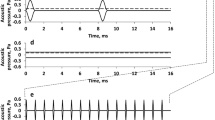Summary
-
1.
The auditory threshold curve of averaged evoked potentials of the colliculus inferior in Rhinolophus ferrum equinum to pure tone stimulation from 1 to 100 kHz is presented (Fig. 1). For pure tone frequencies lower than 14 kHz thresholds steeply rise from 20 to 110 db. The steepness of the acoustical filter for 83.3 kHz signals and the frequency of the echoes heard by Greater Horseshoe Bats is accentuated by averaging methods. Because of averaging, evoked potentials thresholds are lowered by about 20 db compared to those obtained by non-averaging methods.
-
2.
Prominent off-responses in evoked potentials appear for three stimulus frequency ranges: 3–10 kHz with a peak at 5 kHz, 20–40 kHz with a peak at 20 kHz and 80.0–82.6 kHz with a peak at 81.5 kHz (Fig. 2).
-
3.
It is unlikely that beat note frequencies play any role for echolocation.
-
4.
The relevance of these results to echolocation in Horseshoe Bats is discussed, especially as to Doppler shift information contained in the constant frequency part of echoes.
Similar content being viewed by others
References
Grinnell, A. D.: Comparative auditory neurophysiology of neotropical bats employing different echolocation signals. Z. vergl. Physiol. 68, 117–153 (1970).
Kay, L.: Perception of distance in animal echolocation. Nature (Lond.) 190, 361–362 (1961).
—: A plausible theory of the bat's echolocation acuity. Animal Behav. 10, 34–41 (1962).
Neuweiler, G.: Neurophysiologische Untersuchungen zum Echoortungssystem der Großen Hufeisennase Rhinolophus ferrum equinum. Z. vergl. Physiol. 67, 273–306 (1970).
Pye, J. D.: A theory of echolocation by bats. J. Laryng. Otol. 74, 718–729 (1960).
—: Perception of distance in animal echolocation. Nature (Lond.) 190, 362–363 (1961).
Schnitzler, H. U.: Die Ultraschall-Ortungslaute der Hufeisen-Fledermäuse in verschiedenen Orientierungssituationen. Z. vergl. Physiol. 57, 376–408 (1968).
—: Echoortung bei der Fledermaus Chilonycteris rubiginosa. Z. vergl. Physiol. 68, 25–38 (1970).
Tonndorf, J.: Beats in cochlear models. J. acoust. Soc. Amer. 31, 608–619 (1959).
Author information
Authors and Affiliations
Additional information
This study was supported by Stiftung Volkswagenwerk, grant No. 110771 and DFG, grant No. Va 22/4.
Rights and permissions
About this article
Cite this article
Neuweiler, G., Schuller, G. & Schnitzler, HU. On- and off-responses in the inferior colliculus of the Greater Horseshoe bat to pure tones. Z. Vergl. Physiol. 74, 57–63 (1971). https://doi.org/10.1007/BF00297790
Received:
Issue Date:
DOI: https://doi.org/10.1007/BF00297790




